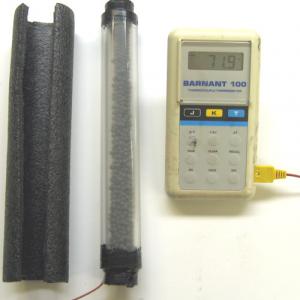College of Liberal Arts & Sciences
4B60.10 - Work Into Heat - Lead Shot
Connect the sealed tube with the lead shot or the copper shot in it to the digital thermometer and measure the initial temperature. Shake the tube violently for either a set amount of time or for a counted number of shakes. Re-measure the temperature. Due to friction between the shot particles the temperature of the shot should have risen by as much a 8 degrees C.
An alternative to the above is to substitute the lead bean bag for the tube and shot. Drop the bag from a 1 meter height about 100 times and the temperature rise should be about 5 degrees C. NOTE: Copper shot can be substituted for a less hazardous demonstration. Copper shot should easily give an 5 to 7 degree C rise in temperature.
A quick and easy way to do this demonstration is to use two Styrofoam cups, some copper shot, and a thermocouple. Fill one of the cups almost full with copper shot and then place the other cup upside down on top of this so that the rims are touching and then tape them together. Run the thermocouple into the end of one cup through a small hole and begin shaking. Observe the temperature rise.
- Harvey S. Leff, "Response to Andersen", TPT, Vol. 50, #5, May 2012, p. 261.
- Poul Winther Andersen, "The Third Man", TPT, Vol. 50, #5, May 2012, p. 261.
- Ronald Newburgh and Harvey S. Leff, "The Mayer-Joule Principle: The Foundation of the First Law of Thermodynamics", TPT, Vol. 49, #8, Nov. 2011, p. 484.
- Thomas B. Greenslade Jr., "Nineteenth‐Century Measurements of the Mechanical Equivalent of Heat", TPT, Vol. 40, #4, Apr. 2002, p. 243.
- F. Paul Inscho, "Mechanical Equivalent of Heat", TPT, Vol. 30, #6, Sept. 1992, p. 372.
- B. Hansson, "Updating Physics", TPT, Vol. 26, #8, Nov. 1988, p. 491.
- R. D. Edge, "The Mechanical Equivalent of Heat", TPT, Vol. 25, #7, Oct. 1987, p. 456.
- Akio Saitoh, "A New Apparatus for Measuring the Mechanical Equivalent of Heat", TPT, Vol. 25, #7, Feb. 1987, p. 97.
- Thomas B. Greenslade Jr., "A Striking Joule’s Constant Determination", TPT, Vol. 18, #3, Mar. 1980, p. 208.
- Thomas B. Greenslade Jr., "Joule's Constant Revisited", TPT, Vol. 17, #8, Nov. 1979, p. 530.
- D. Rae Carpenter Jr. and Richard B. Minnix, "H-405. Shot Shaker - Lead and Pennies", DICK and RAE Physics Demo Notebook, 1993.
- G. D. Freier and F. J. Anderson, "He-1", A Demonstration Handbook for Physics.
- Tik Liem, "Warm a Bottle by Shaking", Investigation to Science Inquiry, p. 184.
- John L. Roeder, "Activity 4: Conversion of Gravitational Potential Energy to Thermal Energy", Teaching About Energy, p. 62.
- David Kutliroff, "59. Converting Gravitational to Thermal Energy", 101 Classroom Demonstrations and Experiments For Physics Teachers, p. 132.
- Borislaw Bilash II and David Maiullo, "Mechanical Equivalent of Heat", A Demo a Day: A Year of Physics Demonstrations, p. 226.
- Robert Ehrlich, "I.10. Mechanical Equivalent of Heat", Turning the World Inside Out and 174 Other Simple Physics Demonstrations, p. 123 - 124.
- Bill Franklin, "Abstract: Shot Drop Lab: Converting Gravitational Potential Energy to Thermal Energy", 2005 Apparatus Competition, Salt Lake City, UT.
Disclaimer: These demonstrations are provided only for illustrative use by persons affiliated with The University of Iowa and only under the direction of a trained instructor or physicist. The University of Iowa is not responsible for demonstrations performed by those using their own equipment or who choose to use this reference material for their own purpose. The demonstrations included here are within the public domain and can be found in materials contained in libraries, bookstores, and through electronic sources. Performing all or any portion of any of these demonstrations, with or without revisions not depicted here entails inherent risks. These risks include, without limitation, bodily injury (and possibly death), including risks to health that may be temporary or permanent and that may exacerbate a pre-existing medical condition; and property loss or damage. Anyone performing any part of these demonstrations, even with revisions, knowingly and voluntarily assumes all risks associated with them.
